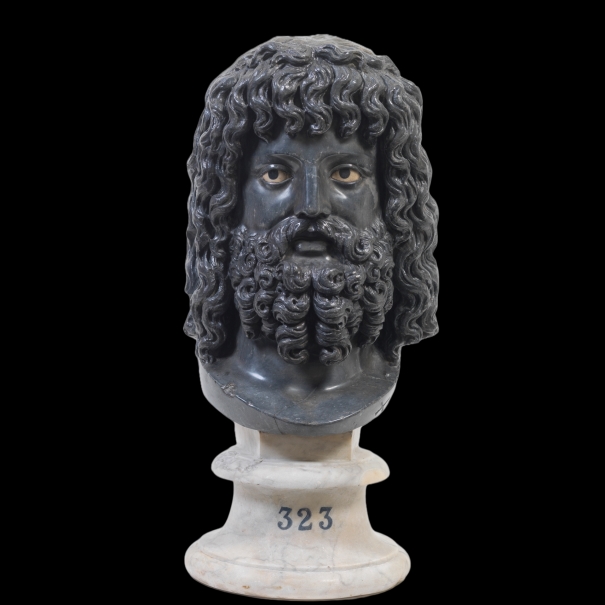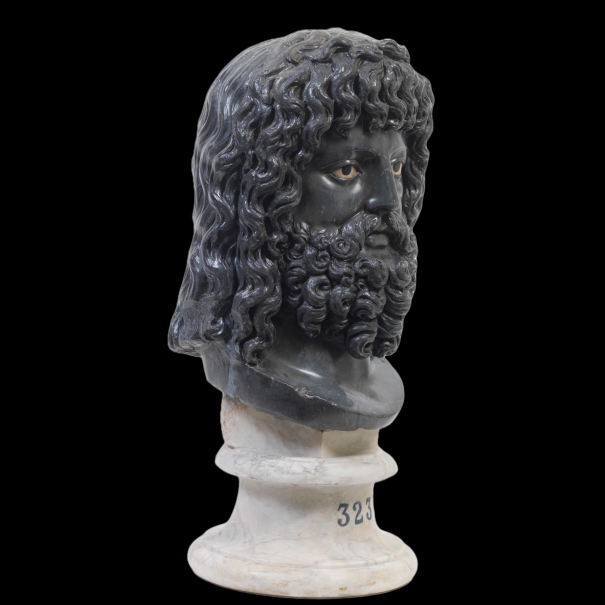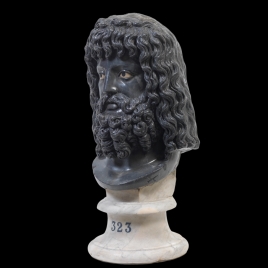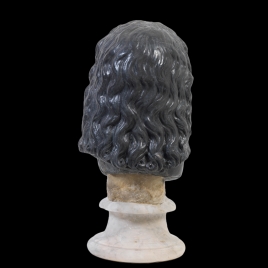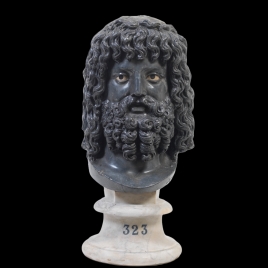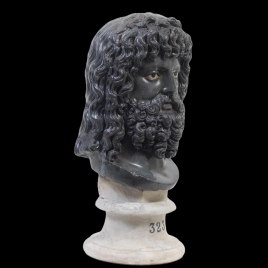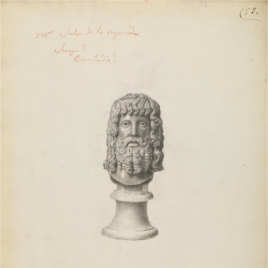Bibliography +
Hübner, Emil, Die Antiken Bildwerke in Madrid, Druck Und Verlag Von Georg Reimer, Berlín, 1862, pp. 89.
Barrón, Eduardo, Catálogo de la escultura. Museo Nacional de Pintura y Escultura., Madrid, 1908, pp. 227, n.323.
Boyer, F., Les Antiques de Christine de Suède a Rome, Revue Archéologique, 1932, pp. 263, n.º 82.
Bieber, Margarete, The Sculpture of the Hellenistic Age, Hacker Art Books, Nueva York, 1955, pp. 83 s., fig. 297.
Blanco Freijeiro, Antonio, Catálogo de la escultura. Museo del Prado, Museo Nacional del Prado, Madrid, 1957, pp. 117.
Castiglioni, L., La statue de culte hellenistique du. Serapieion d'Alexandrie, Bulletin de Musée hongrois des beaux-arts, 12, 1958, pp. 23 ss., figs. 13-19.
Thiemann, Eugen, Hellenistische vatergottheiten: Das Bild des bärtigen Gottes in der nachklassischen Kunst, Aschendorffsche Verlagsbuchhandlung, Münster, 1959, pp. 27 ss.
Helck, H. W., Der Kleine Pauly. Lexicon der Antike I-V, III, Stuttgart: Alfred Druckenmüller, 1969, pp. col. 952, s. v. Manethon.
Vidman, Ladislav, Isis und Sarapis bei den Griechen und Römern, De Gruyter, Berlin, 1970, pp. 18 ss.
Gnoli, Raniero, Marmora romana, Edizione dell'Elefante, Roma, 1971, pp. 165 s., figs. 199, 200.
Fraser, P. M., Ptolemaic Alexandria, Clarendon Press, Oxford, 1972, pp. 246 ss.
Stambough, J. E., Sarapis under the Early Ptolemies, Etudes préliminaires aux religions orientales dans l'empire romain, 25, 1972, pp. 60 ss.
Hornborstel, W, Sarapis, Etudes préliminaires aux religions orientales dans l'empire romain, 32, 1973, pp. 98, nota 5; 243, nota 1, fig. 51.
Kater-Sibbes, G. J. F., Preliminary Catalogue of Serapis Monuments, Etudes préliminaires aux religions orientales dans l'empire romain, 36, 1973, pp. 149, n.º 794.
Fraser, P. M., Sarapis: Studien zur Überlieferungsgeschichte, den Erscheinungsformen and Wandlungen der Gestalt eines Gottes by W. Hornbostel, Journal of Hellenic Studies, 96, 1976, pp. 213 ss.
Hornborstel, W., Hommages à M. J. Vermaseren II, Etudes préliminaires aux religions orientales dans l'empire romain, 68, 1978, pp. 510, con nota 30.
Kyrieleis, H., Stele, Homenaje a N. Kontoleon, 1980, pp. 383 ss., láms. 168, 170, 172, 174.
Blanco, Antonio; Lorente, Manuel, Catálogo de la escultura. Museo del Prado (2ª ed.), Patronato Nacional de Museos, Madrid, 1981, pp. 112.
Elvira Barba, M. A., El Alejandrismo. Tesis Doctoral, Universidad Complutense de Madrid, Madrid, 1981, pp. 84 ss.
Castiglione, L., Alessandria e il mondo hellenistico-romano, I, 1983, pp. 139 ss.
Tran Tam Tihn, V., Sérapis debout, Etudes préliminaires aux religions orientales dans l'empire romain, 94, 1983.
Tran Tam Tihn, V., Etat des études iconographiques relatives à Isis, Sérapis et Sunnaoi Theoi, Aufstieg und Niedergang der römischen Welt, II (17, 3), 1984, pp. 1715, nota 9.
Pollitt, J. J., Art in the Hellenistic Age, Cambridge University Press, 1986, pp. 279 s.
Anderson, Maxwell L.; Nista, Leila, Radiance in stone: Sculptures in colored marble from the Museo Nazionale Romano, De Lucca Edizioni d'Arte, Roma, 1989, pp. 67, fig. 8; 85 ss., fig. 15.
Stewart, Andrew, Greek Sculpture. An Exploration, I, Yale University Press, New Haven, 1990, pp. 202 s., 300 s.
Alvar, Jaime, Los cultos mistéricos en la Tarraconense, en: Religio deorum. Actas del coloquio internacional de epigrafía "Culto y sociedad en Occidente" / editado por Marc Mayer, Tarragona, 1990, pp. 34, nota 34.
Ridgway, B. S, Hellenistic Sculpture, I, The University of Wisconsin Press, Madison, Wisconsin, 1990, pp. 96 s.
Maderna-Lauter, C., Forschungen zur Villa Albani: catalog der antiken bildwerke II, bildwerke in den portiken, dem vestibül und der kapelle des casino / editado por Peter C. Bol, Schriften des Liebieghauses, Mann, Berlin, 1992, pp. 310 ss., notas 20 ss.
Grimm, G., Alexandria, Mainz am Rhein, 1998, pp. 83, figs. 84 a, b; 85 a-c.
Elvira Barba, Miguel Ángel, El Cuaderno de Ajello y las esculturas del Museo del Prado, Museo del Prado, Madrid, 1998, pp. dibujo 53.
Elvira Barba, Miguel Ángel, El Cuaderno de Ajello y las esculturas del Museo del Prado, Museo del Prado, Madrid, 1998, pp. 168 s., lám. 53.
Elvira Barba, Miguel Ángel (ed.), La púrpura del Imperio, Museo Nacional del Prado, Soprintendenza Archeologica di Roma, Madrid, 1999, pp. 112 nº35.
Elvira Barba, Miguel Angel, Bajo el signo de Fortuna: esculturas clásicas del Museo del Prado, Museo Nacional del Prado, Madrid, 1999, pp. 35.
Borea, Evelina; Gasparri, Carlo, L'idea del bello: viaggio per Roma nel seicento con Giovan Pietro Bellori, Edizioni de Luca, Roma, 2000.
Guarducci, Margheritta, “L’iscrizione sul monumento del Carroccio in Campidoglio e la sua Croce radiata”, L'Erma di Bretschneider, Roma, 2003, pp. 99-108.
Luxan Rodriguez, Elena, Bibliotheca Alexandrina : Homenaje a la Memoria, Apuesta por..., Biblioteca Nacional, Madrid, 2003.
Schröder, Stephan F, Catálogo de la escultura clásica: Museo del Prado II, Museo Nacional del Prado, Madrid, 2004, pp. 429-433.
Schröder, S.; Elvira Barba, M.A, "Eutichio Ajello (1711-1793) y su descripción de la célebre Real Galería de San Idelfonso", Boletín del Museo del Prado, XXIV, 2006, pp. 40-88.
Roma e l' antico : realtà e visione nel ´700, Skira, 2010, pp. 456/293.
Elvira Barba, Miguel Angel, Las esculturas de Cristina de Suecia: un tesoro de la Corona de España, Real Academia de Historia, Madrid, 2011, pp. 36,75 / 99.



